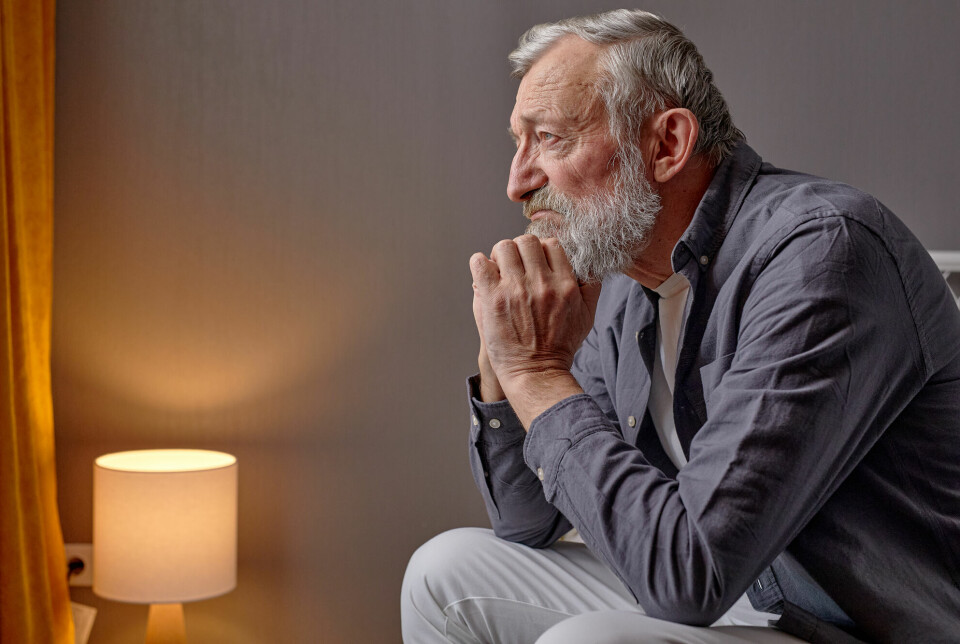
Elderly suicide rates are on the rise. Home healthcare services have an important responsibility
The greatest increase in the number of suicides in recent years has been among seniors over 80 years old. Healthcare professionals can detect suicide risk among the elderly but lack the necessary resources, according to a new study.
Suicide is one of the major public health problems of our time.
Norway registered 610 suicides in 2022. No fewer than 170 of them were carried out by elderly people over the age of 60.
This number corresponds to over a quarter of the suicide cases. The greatest increase in the number of suicides has been in the 80-89 age group over the past two years.
Widowers and single men
With the launching of Norway’s Coordination Reform in 2012, the elderly are receiving care in their own homes more often than they used to.
“Home service healthcare personnel have an important responsibility when dealing with elderly people living at home who are at risk of suicide,” says researcher Lise-Merete Alpers. She is an associate professor at VID University College.
Most viewed
Alpers and master's student Anne A. Monsen have researched the experiences of healthcare personnel with suicide risk in elderly people living at home.
Widowers and single men dominate the suicide statistics.
Older men are also more determined when they want to end their lives, and their methods are more radical.
Dark figures
There are probably dark figures for suicide among the elderly over 65 as well. Their deaths are not always reported as suicides, even if suicide is suspected.
Other causes of death are often listed, and autopsies are carried out less often.
“Despite the fact that suicide is widespread among the elderly, it has received little attention,” Alpers says. "This trend is why the spotlight needs to be directed on the elderly and their risk of suicide."
Life seems meaningless
The researchers conducted in-depth interviews with home healthcare employees in one large and one small municipality in Norway.
Many elderly people find their lives meaningless, according to home healthcare staff.
They feel lonely and that they are a burden to others.
All the informants had encountered loneliness and social isolation among the elderly.
Many seniors have lost large parts of their social circle. Physical and mental illness and an increased need for help also add to their loneliness.
Losing a spouse is a risk
Major life changes, such as losing a partner, also lead to loneliness for many and can increase the risk of suicidal behaviour.
One informant put it this way:
They find themselves in situations where they lose their partner whom they’ve lived with for 50 or 60 years. Their health fails and loneliness increases. Then they might wonder, “Why should I continue?”
Increased mortality when depression goes untreated
Previous research shows that 19.5 per cent of elderly people living at home are often or always lonely.
However, few people over the age of 65 receive mental health care compared to other age groups.
“The reason could either be that older people don’t want mental health care because they feel it’s stigmatising, or that they aren’t informed about the service,” says Alpers.
Many elderly people who become depressed are probably not diagnosed, according to the researchers.
Without treatment, mortality in the elderly population is three times the average rate.
Didn't see it coming
Another warning sign is when elderly people who are in need of care feel like a burden on relatives and the home healthcare services.
One informant said:
We had... a man with a lot of somatic complaints, who expressed that he was depressed. We kind of didn't pick it up. I think he just got fed up and he felt like he was a burden on his wife and the home healthcare service.
Detecting mental illness requires healthcare workers to have knowledge and understanding of elderly people’s vulnerability.
But employees in home healthcare often find that their contact with the elderly is too sporadic.
They feel like they have too little time in their schedule for extra conversations.
Suicide prevention measures vary
The Norwegian government introduced a zero vision for suicide in 2020.
The action plan will contribute to making the prevention of suicide a higher priority.
However, the informants pointed out that measures to prevent suicide among the elderly vary from one municipality to the next.
The way that home healthcare services are organised influences how well healthcare personnel are able to connect with the elderly.
Few low-threshold services
A few suicide prevention measures offer low-threshold services, according to informants.
Some of the informants believed that elderly people who live at home do not get enough help, including from the specialist health service.
Others said that the elderly are not prioritised for psychiatric referral, which tends to focus on younger people.
One of the municipalities offers a low-threshold service that works to help elderly people who have lost contact with relatives.
Preventive responsibility – and opportunity
In line with the Coordination Reform, older people are being discharged from hospital more quickly than before.
The number of elderly receiving municipal care services at home has increased considerably.
The home healthcare service has increased the responsibility of healthcare personnel in detecting patients with depressive symptoms – as well as the opportunities to do so.
For many elderly people, the home healthcare visit is the highlight of their day.
Symptoms often appear as vague comments, like: "Now I give up" or "I can't take it anymore."
“But that requires that healthcare personnel have good relationships and can communicate well with the elderly,” says Alpers.
Being able to detect the risk of suicide requires having consistent staffing with the elderly, according to the informants.
———
Translated by Ingrid P. Nuse
Read the Norwegian version of this article on forskning.no
Reference:
Monsen, A. & Alpers, L.M. Helsepersonells erfaringer med selvmordsrisiko hos hjemmeboende eldre personer (Healthcare personnel's experiences with suicide risk in elderly people living at home), Nursing Research, 2023. DOI: 10.4220/Sykepleienf.2023.93191





































